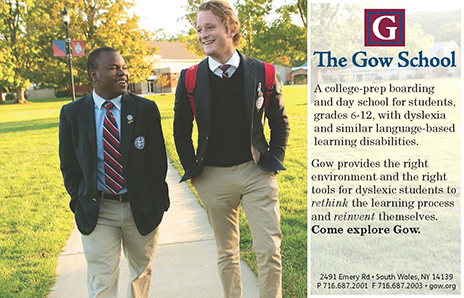Diplomacy Works—First-Person Stories from the Field
U.S. diplomacy is vital to American prosperity and national security and to maintaining a peaceful world. Here are some examples of the critical work diplomats do.
As part of AFSA’s mission to tell the story of the Foreign Service, The Foreign Service Journal has begun building a collection of narrative “case studies." We reached out to the association’s membership, asking for their stories of a time, an event or a day when diplomacy achieved an important objective. The response has been excellent, such that the compilation here is Part I of what promises to be a continuing series. We will publish Part II in January. Written by active-duty and retired members of the U.S. Foreign Service, these accounts offer vivid illustrations of the indispensable everyday work of career diplomats and development professionals around the world. If you have a story to add, please send it to journal@afsa.org, with subject line “Diplomacy Works."
—The Editors
A Flag Is Better than a Thousand Words
SOVIET UNION 1991 • BY RAYMOND SMITH
On the morning of Aug. 19, 1991, hard-line Soviet leaders were attempting to solidify their coup against Soviet President and General Secretary Mikhail Gorbachev. At the U.S. embassy, we were scrambling for information, advising Washington on the conditions that could lead the coup effort to collapse (large-scale public resistance and doubts that the military would follow orders to crush the resistance to it), and recommending that the U.S. government refuse all contact with the coup leadership.
I was about two weeks short of completing my three-year tour as head of Embassy Moscow’s political section. We were between ambassadors, and Jim Collins, normally the deputy chief of mission, was in charge.
At about midday, Jim told me that he had gotten a request from Russian President Boris Yeltsin (the centerpiece of resistance to the coup) to call on him at Russian government headquarters, which overlooked the embassy compound from a couple hundred yards away. Crowds had converged on the headquarters, locally known as the White House, and were building barricades around it with whatever materials they could find. If the coup leaders tried to use force, this was where it would happen.
Jim asked for my views, and I told him that I thought we should go see Yeltsin. We had long supported Gorbachev’s reform effort, although we had also advised Washington that the effort was in trouble and that even the continued existence of the Soviet Union was in doubt. Success of the coup would mean the end of reform and, probably, a reversion to hostility between our countries. There was no doubt the coup leaders would be well aware of our visit to Yeltsin and would understand how the United States felt about their effort to grab power.
Jim made a call to the State Department on the embassy’s secure line and obtained agreement to accept Yeltsin’s invitation. A few minutes later, we climbed into the ambassador’s limousine and, American flag flying to show that the head of the embassy was aboard, made the short drive to the White House, moving carefully up the ramp as cheering crowds pulled down their makeshift barriers to allow us entry. It was as clear to them as it was to the temporary occupants of the Kremlin what this meant.
Two days later, the coup collapsed. Gorbachev was released from house arrest in the Crimea and returned to a capital that he no longer ruled. Yeltsin was now the dominant leader, and a few months later he led Russia out of the Soviet Union, consigning the 1917 communist revolution to the dustbin of history.
The coup collapsed for the reasons we said it might: the bravery of the Soviet citizens who risked their lives to resist it and the unwillingness of key members of the Soviet military to use force against their own people. We at the embassy had done what diplomats can. We provided our leaders with information and advice. We recognized and took advantage of the opportunity to demonstrate publicly where the United States stood at this critical juncture in the political life of the country to which we were accredited.
Señora Luna’s Cooking Pot
BOLIVIA 2003 • BY ALEXIS LUDWIG
One afternoon in late November 2003, Pete Harding, then human rights officer at U.S. Embassy La Paz, was returning to his office after a working lunch with one of his social sector contacts. As he entered the chancery lobby and made his way toward the elevators, Harding noticed a middle-aged woman of indigenous ethnic origin stepping away from the embassy cashier’s window. She was dressed nondescriptly, in jeans, a long-sleeved white T-shirt and blue vest. But something about her was off.
She held a large black cooking pot in her arms, and tears were streaming down her face. Harding felt the stirrings of sympathy and curiosity. He introduced himself, and guided the woman to a seat in the back corner of the lobby.
Harding discovered that the woman, Señora Gaby Luna Velasco, had recently lost her home to a fire. Señora Luna’s two-story home in the Eloy Salmon commercial neighborhood near downtown La Paz doubled as a small business: the structure’s ground floor was a shop from which she and her family sold domestic appliances. Her home, that shop and all the merchandise in it were now gone. Everywhere she had gone to seek help, she had been turned away. Bolivian government ministries, the central bank and other local institutions had been unresponsive. The Bolivian bank branch in the embassy chancery had just told her “sorry” for a second time.
Harding peered inside the cooking pot and saw a pile of what looked like blackened ashes and smelled like burnt paper. It was several seconds before he realized what he was seeing and smelling: the remains of several clumps of U.S. one hundred dollar bills. The charred bills were all that was left of her family’s life savings, which included the money she had recently collected from neighbors to pay for merchandise. She claimed that $45,000 in cash had been hidden beneath her mattress at the time of the fire, and she sought help to convert the ashes back to viable legal tender.
Señora Luna’s story rang a bell: Harding recalled having read about the devastating nighttime fire not long before in the local papers. And he knew it was plausible. The “informal” sector represented two-thirds of Bolivia’s economy—the country’s growing cholo commercial class owned the street stands and lunch stalls, small bric-a-brac shops, hardware stores and food markets, and ran the thriving commerce in mostly contraband electrical goods and computer electronics. They administered this substantial informal economy almost exclusively in cash—often in U.S. dollars rather than the local currency.
He was the bridge, the interpreter, the sole point of intersection between those worlds—doing his best to bring them together to solve a problem. —Alexis Ludwig
Whatever the case, Señora Luna needed help. She had no insurance. She had nothing left, owed money for all the merchandise destroyed in the fire and had intended to pay off her debt with the charred cash in the cooking pot. Harding asked her to wait in the lobby while he went inside to consult with embassy colleagues about whether there was any way he could help. He returned an hour later to tell her he would do what he could. From his professional point of view, helping a woman of Señora Luna’s background would have precisely the kind of political impact we were seeking. More importantly, however, it was the right thing to do. (He could not stop asking himself: What if it were my own mother in this situation?)
They transferred the contents of her cooking pot into several thick, industrial-style plastic bags. Back in his office, Harding placed these bags into a cardboard box, secure-wrapped it and mailed it to the U.S. Treasury Department’s Bureau of Engraving and Printing in Washington, D.C.
During the months that followed, Harding made multiple calls to Washington to seek updates and press for progress. Señora Luna’s box had arrived just as the Bureau was responding to a surge stemming from forest fires in California, and the office’s expert currency examiners were working at full throttle, unable to give their immediate attention to the case from distant Bolivia. When the distraught Señora Luna called him pleading for news, Harding assured her it was just a matter of time.
He explained the bureaucratic process; that complex currency examination cases were time-consuming; that accurate calculations were critical; and that the workload of currency examiners was heavy. In short, he performed the diplomat’s quintessential task, mediating between two otherwise separate worlds. He was the bridge, the interpreter, the sole point of intersection between those worlds—doing his best to bring them together to solve a problem.
The solution came in early June, more than six months after he had mailed the box of burnt bills to Washington. It was a U.S. Treasury check in the amount of $17,100. When Harding called with the good news, Señora Luna was overcome with emotion. He was happy for her, pleased that their persistence had paid off and relieved he had not oversold his ability to come through on his implied promised, after all.
To commemorate the event, the embassy’s public affairs office organized a special ceremony in the chancery lobby. Harding and U.S. Ambassador to Bolivia David Greenlee formally presented the check to Señora Luna. Amb. Greenlee received a grateful kiss on the cheek from the tearful woman, a gesture that was broadcast on national TV that same night. It also appeared on the front pages of Bolivian papers the following day, above feature-length accounts of her travails and their successful resolution—with the help of U.S. Embassy La Paz.
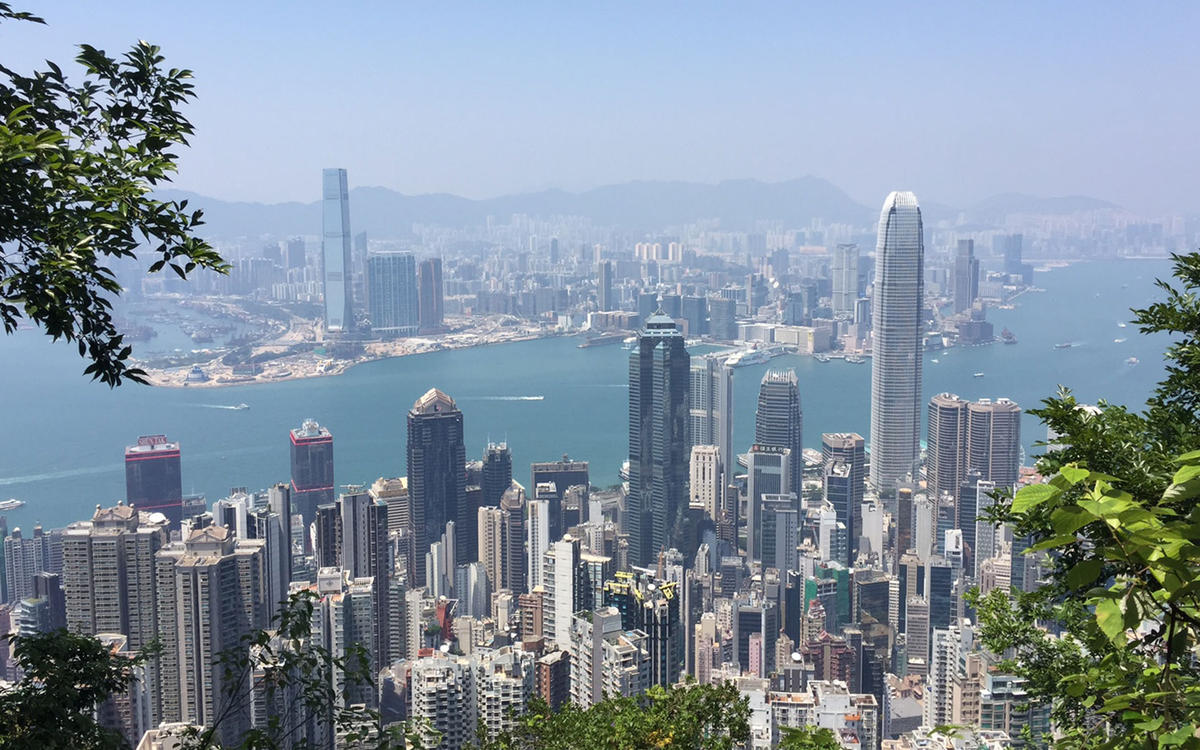
View of Hong Kong.
Photo Courtesy Richard W. Mueller
Navigating Hong Kong’s Return to China
HONG KONG 1992 • BY RICHARD W. MUELLER
United States diplomacy and law were critical in continuing our deep and extensive relationships with Hong Kong and China after July 1, 1997—the date Hong Kong returned to Chinese sovereignty and became a special administrative region of China. Without the multiyear effort of the Department of State, Congress and other federal agencies, we would have been unable to work with Hong Kong, China and the United Kingdom to maintain many of the important relationships allowed by China’s unique “one country, two systems” formula for Hong Kong.
Without the U.S.-Hong Kong Policy Act of 1992 and subsequent detailed negotiations, we would have had to impose the same restrictive relationships that we had with the PRC on Hong Kong—an open, free market territory with a solid tradition of liberties and law. This would have created a crisis not only in Hong Kong but in our relationships with China and other countries.
Some important background: In 1898, Great Britain forced on a weakened Qing dynasty a treaty extending (via a 99-year lease) the boundaries of Hong Kong well beyond the island and the tip of the Kowloon Peninsula, which had been seized by Britain in 1842 and 1860, respectively. Claude MacDonald, Britain’s negotiator, declared that 99 years was “as good as forever.”
But as China began to open up during the 1980s, the 1997 deadline loomed frighteningly close. The question of Hong Kong’s future status was on everyone’s minds, both before and after the 1989 Tiananmen Square crackdown in Beijing that drove people and capital to seek safe haven.
No option other than the return of sovereignty was acceptable to China. But a straight handover and the imposition of Chinese laws and governance would have caused untold chaos and decline in Hong Kong, an important international financial and trading center.
In the fall of 1983, as chief of the economic section at U.S. Consulate General Hong Kong, I witnessed a foretaste of what a failure to secure the future might mean. A severe crash in the Hong Kong dollar and the stock market, along with panic buying of essentials, gripped the city for days in the wake of a collapse in high-level United Kingdom-China negotiations.
In recognition of the reality of the situation, a “pragmatic” Deng Xiaoping supported the subsequent negotiation of the Sino-British Joint Declaration of 1984, which was later entered into Chinese law as “one country, two systems.” Hong Kong’s status as a special administrative region of the PRC would continue until 2047. The socialist system of China would not be practiced in Hong Kong, and its capitalist system, common law, liberties and way of life would continue.
Without the U.S.-Hong Kong Policy Act of 1992 and subsequent detailed negotiations, we would have had to impose the same restrictive relationships that we had with the PRC on Hong Kong. —Richard Mueller
In creating this new framework, Deng Xiaoping was keenly focused on the longer-term political imperative of bringing home Macau, still under Portuguese sovereignty and, even more important, Taiwan. (Macau reverted to China in 1999; Taiwan has declined to negotiate on such a framework.)
What was the U.S. role? Importantly, we needed a legal basis to conduct our relationship with Hong Kong differently from its sovereign. Thus was born the U.S.-Hong Kong Policy Act of 1992.
As a career FSO and deputy assistant secretary for legislative affairs under Secretary of State James Baker, I was asked to be the point person for our negotiations with Congress, working closely with State’s Office of the Legal Adviser, the Bureau of East Asian and Pacific Affairs and others. There was intense interest in many quarters of Congress; Senator Mitch McConnell (R-Ky.) was a lead sponsor of the bill. Much of our initial work was educational: What was the history? Why did we need new authorities? What were U.S. objectives?
An early crisis arose when the Chinese embassy in Washington, D.C., harshly criticized our work, mistakenly believing we were copying the oft-denounced Taiwan Relations Act. We were able to explain the differences and remind them that China had requested that we and other countries build a future relationship based on “one country, two systems.”
Working closely with members of Congress and their staff, we spent many months drafting the U.S.-Hong Kong Policy Act’s findings, policies and specific authorizations allowing a broad variety of relationships to continue, such as economic and trade relations (most-favored nation status), law enforcement cooperation, differential export controls, support for maintenance of consular and trade offices, support for Hong Kong’s continued participation in international organizations, educational and cultural exchange, human rights, Hong Kong’s common law and others.
The legislation garnered widespread support and passed both the Senate and House unanimously in October 1992. Months later, I arrived in Hong Kong as the new American consul general. A top priority for my next three years—and for my successors—was fleshing out these policies and authorities. In many cases we needed to negotiate with the Hong Kong, British and Chinese governments, as well as our U.S. government colleagues, to ensure they aligned their policies and practices. There was generally a positive view among all actors of how the continuing relationships would serve common and differing interests. There was also recognition that under U.S. law the president could suspend differential treatment if Hong Kong’s autonomy was not maintained.
Twenty-five years later, the U.S.-Hong Kong Policy Act continues to serve as a guidepost to U.S. interests and national security goals. It has helped us support the continuation of Hong Kong as an important venue for concluding trade and investment agreements, resolution of legal disputes, a free flow of information and U.S. Navy ship visits, among other things. While the last two decades have seen many changes in China and Hong Kong—some of them worrisome for long-term maintenance of Hong Kong’s unique status—our diplomatic and legal efforts have paid off handsomely in sustaining our rich and complex relationships across the Pacific.
Supporting the Casamance Peace Initiative
SENEGAL 2012 • BY JAMES R. BULLINGTON
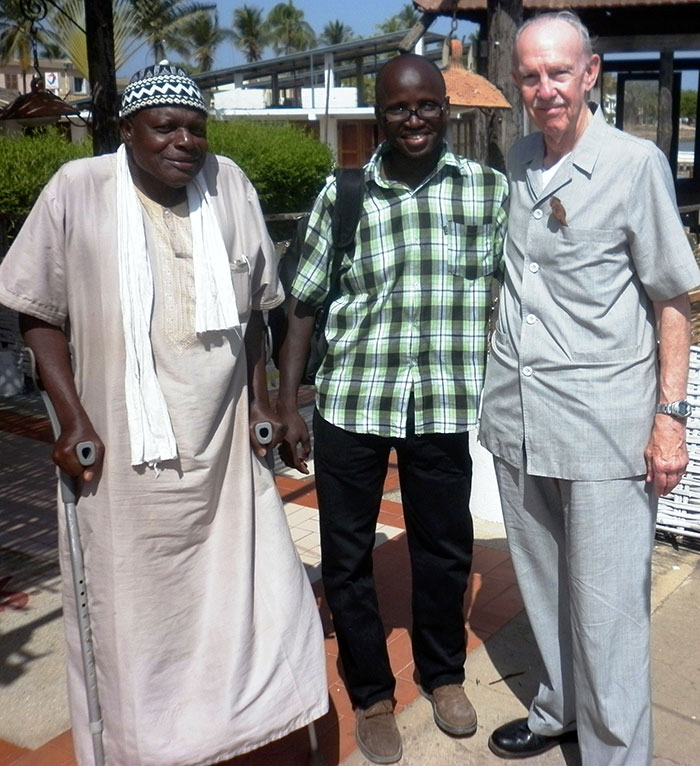
James Bullington (right) meets with leaders of the Mine Victims Association in Ziguinchor, capital of the Casamance region, in 2013.
Photo Courtesy of James R. Bullington
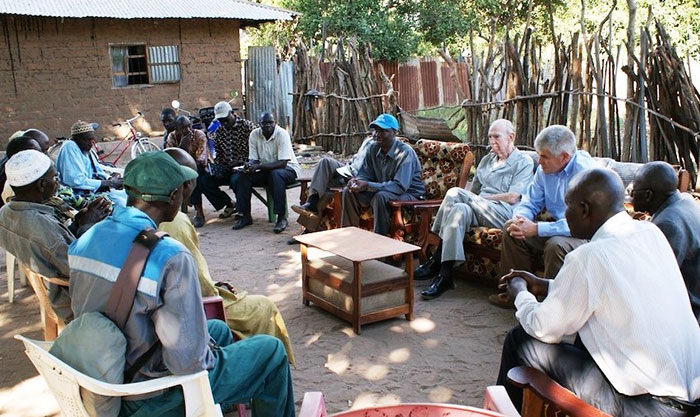
Bullington (fourth from right) and U.S. Ambassador to The Gambia Ned Alford (third from right) meet with refugees from the Casamance in The Gambia.
Photo Courtesy of James R. Bullington
In 2012, one of the candidates in Senegal’s presidential election, Macky Sall, campaigned on a promise to end a secessionist insurgency that had persisted in the southern part of the country, the Casamance, for 30 years. It had resulted in hundreds of deaths, thousands of refugees, a crippled economy and a politically unstable region increasingly vulnerable to Islamist extremism and international narcotics trafficking.
When Sall won and indicated he would welcome international assistance in implementing his campaign promise, Rebecca Wall, a member of a small team of election observers sent by the newly created State Department Bureau of Conflict and Stabilization Operations, saw an opportunity to promote our interests and those of one of our most important African allies.
Peace in the Casamance, she and her colleagues reasoned, would eliminate a source of political instability, encourage economic development and free up Senegalese military resources for participation in United Nations peacekeeping operations and countering Islamist extremism in West Africa. CSO sold this idea to Secretary of State Hillary Clinton, who visited Dakar in July 2012 and offered our help to President Sall. He accepted.
I had been in touch with Rebecca and CSO for several months in an effort to find a job that would alleviate my growing boredom in retirement. My qualifications—fluent French, ambassadorial rank and lots of experience in Africa and in conflict situations, including Vietnam, Chad and Burundi—fit their needs for the Casamance project. I began work as a re-employed annuitant and, after several days of consultations in Washington, arrived in Dakar in mid-October.
My welcome by the Senegalese government and people was enthusiastic, not because of any personal merit, but because of what my appointment represented—the official engagement of the U.S. government to support the Casamance peace initiative. This illustrates an important point: American participation is vital to address many global issues, as other governments and people often look to Uncle Sam for leadership and backing.
Over the next two years, this U.S. engagement in support of Senegal’s effort to end the Casamance conflict was instrumental in mobilizing international reconstruction and development aid for the region; facilitating negotiations between the government and the rebels; launching a disarmament, demobilization and re-insertion program for rebel fighters; and beginning the resettlement of refugees who had been displaced by the conflict.
The CSO Casamance project was highly cost-effective. It consisted of me, a part-time deputy (retired FSO Sue Ford Patrick) whom I recruited in Dakar and one officer (Rebecca) to support us in Washington, D.C., plus $1 million in Defense Department funds that were made available to State. This illustrates another important point: diplomacy is almost always the most cost-effective tool in the national security toolkit.
Most insurgencies don’t end with a signed peace agreement; they just fade away. This has been the case in the Casamance. A de facto ceasefire began a few months after my arrival, and it still holds while negotiations continue. A few hundred rebels have left the fight and started the disarmament and demobilization process. Several thousand refugees have returned to their homes. Reconstruction and development aid have surged.
With the Casamance burden lightened, Senegal’s highly professional military forces were able to continue their participation in United Nations peacekeeping operations in Africa. They joined other West African countries in restoring democratic governance to The Gambia after its president refused to abide by election results, and sent an Army battalion plus police forces to support the French-led operation in Mali that is blocking a threatened takeover of that country by jihadi extremist groups.
It is rare to hear praise for U.S. diplomacy from the lips of a French professor, especially when it involves Francophone Africa. Thus the remarks of Prof. Jean-Claude Marut, the world’s leading academic expert on the conflict, at a 2015 seminar, “The Role of American Diplomacy in the Casamance Crisis,” were especially gratifying: “American diplomacy achieved its objective ... thanks to their mediation offer together with the appointment of a Casamance representative. … The American involvement inspired more confidence, due to the weight of American diplomacy ... it enabled the financing of the [rebel] delegations that traveled to the Rome negotiations ... [and it led to] a ceasefire that is still in place. … The Americans supported demining. They facilitated the return of refugees, and they brought The Gambia [which had protected the rebels] back into the game.”
We did not restore peace to the Casamance. President Sall, the Senegalese government and the people of the region deserve credit for that. But our support was vital to the success of Senegal’s Casamance peace initiative.
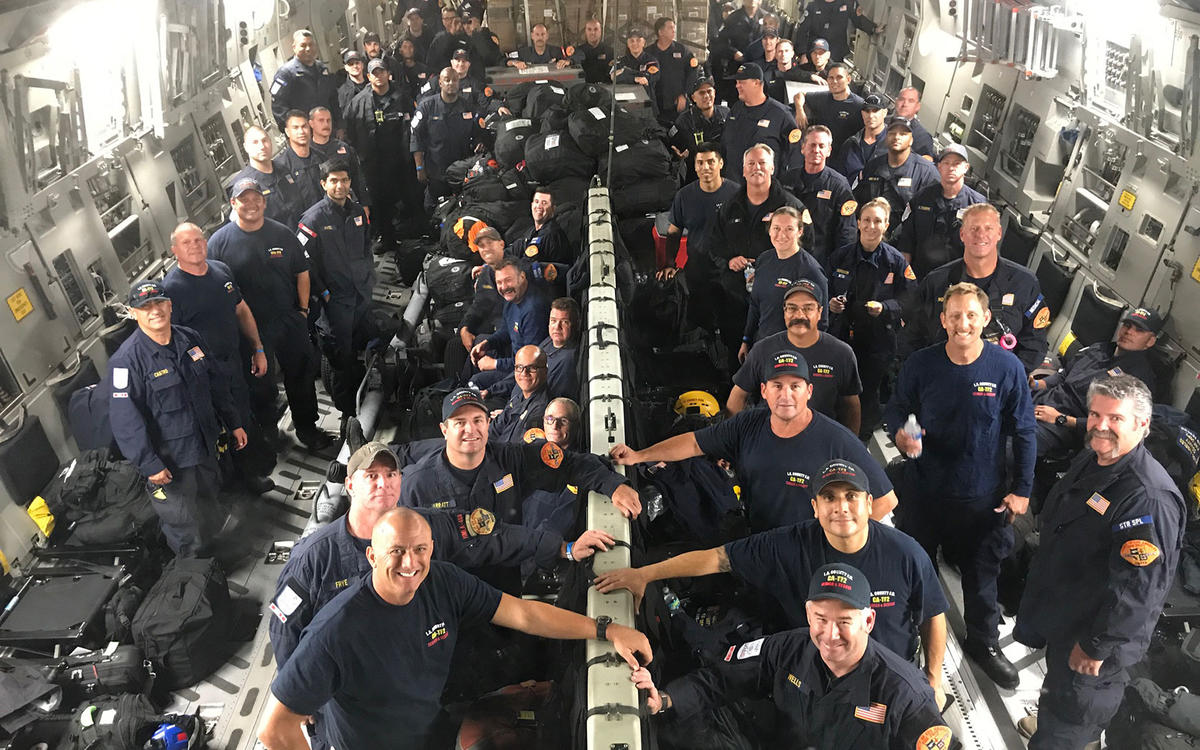
After the Sept. 19 earthquake in Mexico, USAID’s Office of U.S. Foreign Disaster Assistance deployed a response team.
Photo Courtesy of Alex Mahoney
Assistance after a Severe Earthquake
MEXICO 2017 • BY ALEX MAHONEY

Members of USAID’s elite disaster response team took part in a 24-hour effort to search a collapsed office building.
Photo Courtesy of Alex Mahoney
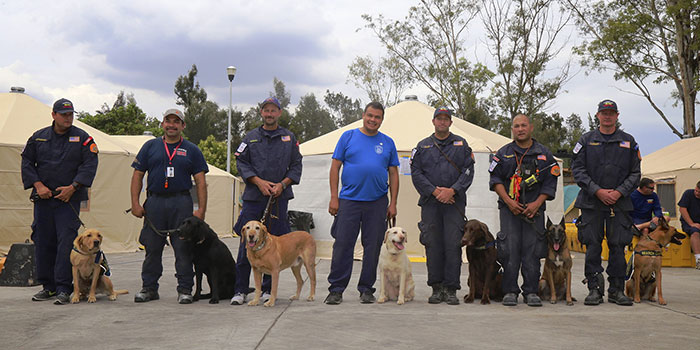
American canine teams meet up with Tijuana-based teams.
Photo Courtesy of Alex Mahoney
On Sept. 19, a magnitude 7.1 earthquake struck approximately 75 miles from Mexico City, killing more than 355 people, injuring at least 6,000 others and damaging about 44,000 buildings across the region. It was the same day that a deadly earthquake had struck the city 32 years before, and less than two weeks after a magnitude 8.1 earthquake shook the southern coast of Mexico.
The U.S. Agency for International Development’s Office of U.S. Foreign Disaster Assistance—which leads the U.S. government’s response to international disasters—immediately stood up a response team in Washington, D.C., to coordinate activities in support of the government of Mexico. At first we didn’t know if we would be responding, for one of the criteria for USAID to assist to with an international disaster is that the affected government must either request U.S. government assistance or be willing to accept it.
Since 2002, USAID’s Office of U.S. Foreign Disaster Assistance has worked with Mexican disaster authorities to strengthen their search-and-rescue capacity. USAID supported training exercises for first responders, as well as for instructors, who have now trained more than 1,300 firefighters and first responders on search-and-rescue techniques. Because the Mexican government has its own robust disaster response capabilities, it seldom asks for additional assistance from the United States. However, after the Sept. 19 earthquake, in addition to mobilizing its own national resources to respond to the disaster, the government of Mexico accepted the U.S. government’s offer of assistance.
USAID deployed a Disaster Assistance Response Team comprised of 15 disaster experts, as well as 67 members of the Los Angeles County Fire Department Urban Search and Rescue (USAR) Team and five canines. It was the 17th time since 1988 that USAID deployed a USAR team to help with international rescue efforts.
For more than a week, the team worked with others from across the globe in an around-the-clock effort to search for survivors. Working in tandem with Mexican teams, DART’s USAR team searched eight buildings—including the 24-hour scouring of a collapsed office building. DART structural engineers also assisted the Mexican government in the assessment of more than 50 damaged buildings, helping to determine whether it was safe for people to return to their homes and for schools, clinics and offices to reopen.
The USAR members of DART were one of the last teams to depart Mexico City. At the request of the Mexican government, the team helped coordinate the demobilization process for the other international search teams and worked with Mexican counterparts to strengthen their capacity to implement this process in the future.
In addition, USAID is working with the Mexican Red Cross to render assistance to the elderly, the disabled and those who were injured in the earthquake. We also supported the transfer of some of the USAR team’s search-and-rescue equipment and supplies to the Mexican Red Cross to help with continuing relief efforts. This includes saws, hand tools, generators, fuel containers, tents, cots and portable sinks and showers.
A week and a half after their arrival, USAID’s DART returned home. Though our USAR members did not find any survivors, we are incredibly proud of what our team accomplished. Helping people around the world after disasters strike represents the best of America, and we did everything possible to help our neighbors in Mexico during their time of need.
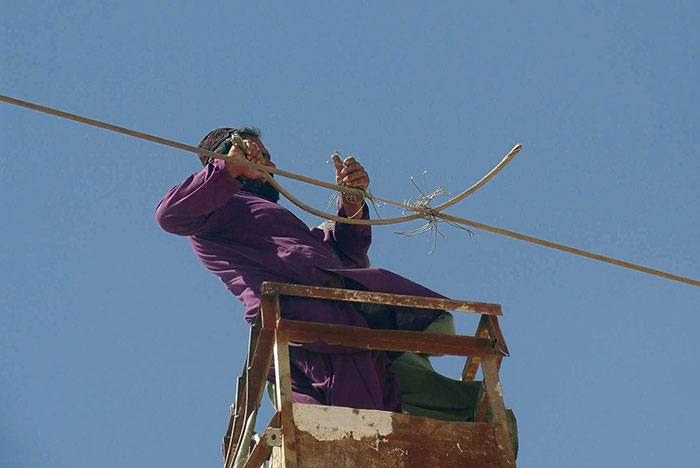
An Afghan linesman works to fix a flaw in the 200-km transmission line delivering electricity from the Kajaki power plant.
Photo Courtesy of Jeremiah Anthony Carew
Power Plant Projects Local Power
AFGHANISTAN 2016 • BY JEREMIAH ANTHONY CAREW
Kajaki Dam has figured large in our engagement in Afghanistan for more than half a century. The story of how the hydroelectric project there was finished illustrates how development actually works in the field.
In 2003 I was a junior consultant working on the U.S. Agency for International Development’s Afghanistan desk. When a senior manager announced portentously that we were “going back into Kajaki,” I remember quickly googling “Kajaki” to find out why this was such a big deal. As I learned, the U.S. irrigation and power generation project in Helmand province—started in the 1950s and further developed in the 1970s—had a lot of history before we re-engaged on it.
Over the decades, it moved slowly, beset by obstacle after obstacle, even though it remained a key piece of infrastructure for southern Afghanistan. In 2009, during my first overseas tour in USAID Afghanistan’s infrastructure office, we were frustrated. A year earlier, a major British-led military operation had transported a third turbine for the dam by land through Taliban-held territory despite loss of life. But because of the security conditions and contracting difficulties, we were unable to install it.
In 2015, I returned for a second tour in Afghanistan. Just days into the tour, I sat nervously in the mission director’s office as the decision was made to evacuate the Kajaki site due to nearby indirect fire. Starting in September of that year, a colleague took the initiative and, working closely with the ambassador, managed to remobilize at Kajaki by early 2016. When he left in July, I took over to lead the team through the final stretch to project completion, anticipated in October.
A critical issue when I took over was the state of the transmission line connecting Kajaki to nearby towns and cities. It was conventional wisdom that, although Kajaki would be able to produce significantly more power when our project was completed, the transmission line was so badly deteriorated that it would not be able to transmit the additional power. Yet another years-long project would be needed to upgrade that line.
In August we invited the CEO of the Afghan power utility company, Da Afghanistan Breshna Sherkat, for dinner, and talked through the game plan for the critical final months of the project. In between bites of food, the CEO casually announced that DABS would be rehabilitating the transmission line while power was shut off from the dam, taking advantage of the outage to do long-needed work. We were dumbfounded. The CEO’s announcement contradicted years of experience-based assumptions on our part. If true, it was a game changer—we could not only finish Kajaki by October, but get that additional power out to homes and businesses at the same time.
I immediately called together the USAID and contractor engineering staffs to test the engineering behind what the CEO had told us. Our analysis indicated that his plan was possible but risky—if the security situation prevented DABS linesmen from accessing the entire line, any small flaw in its 200-kilometer length could mean failure. Like a lightbulb filament, the line would simply melt and pop when power was increased.
We told DABS they had our full support to implement this audacious plan and offered significant amounts of transmission cable we had in stock to assist. The DABS head of operations in the Kandahar region, a savvy engineer named Rasool, explained the plan to us: They would rent additional bucket trucks and deploy double shifts each day of the outage to repair the line.
September 2016 was a nerve-wracking month, but the days went more smoothly than expected as the team completed turbine installation on schedule and commissioned the new unit.
Meanwhile, Afghan linesmen from DABS heroically endured blazing desert heat, kidnappings and double shifts to untangle and repair damaged line bit by bit and, in the worst stretches, replace it with new line. By early October, DABS was nearly ready to begin testing the additional power on the transmission line.
We lost a couple of weeks when, in classic Afghan fashion, a village along the line would not grant DABS engineers access without a promise of more power from the dam. Having DABS out front negotiating with their own people was critical, and they successfully reached a compromise.
In the end, the project was completed. As the reporting cable stated: “Now that Unit 2 is online, the Kajaki Hydroelectric Power Plant has the capacity to generate 50 megawatts of electricity compared to a previous maximum of 32. Kandahar city presently receives an average of 16-17 megawatts, compared to a low-season average of 9 prior to the installation of Unit 2.”
Development works when the host country leads, and we support. Local knowledge holds the key to success, provided we listen closely and can pair it with our technical knowledge. We got the Kajaki project done together, with the Afghans in the lead.
Which Way Will Bucharest Go?
ROMANIA 1991-1994 • BY ANTHONY M. KOLANKIEWICZ
After the collapse of communism in Eastern Europe in 1989, Washington was not sure which direction Bucharest would go. The first Romanian president after the fall of Nicolas Ceausescu had been educated in Moscow and was pro-Russia by temperament and experience. He pressed for a slow, incremental transition toward democratic institutions and a market economy. The weak, fragmented democratic opposition favored a quicker process, but struggled for relevance within a conservative society.
I served as a political officer at U.S. Embassy Bucharest from 1991 to 1994, my first overseas assignment as a tenured officer. My responsibilities centered on keeping in touch with the opposition political parties, including the trade union movement.
The main trade union in the country was the former communist workers’ organization, known by the Romanian acronym CNSLR. I met with its leadership frequently, most of the time on my own but occasionally with the local representative of the Free Trade Unions Institute. The FTUI was the European arm of the AFL-CIO and reported directly to AFL-CIO headquarters in Washington, D.C.
The CNSLR president, Victor Ciorbea, told me repeatedly during the first year of my assignment that his goal was to transform the former communist trade union into a credible democratic institution. I was skeptical, since many other former communist organizations in Romania at the time spoke about similarly positive plans but made little real effort to change.
Mr. Ciorbea began to implement some of his plans during my second year in Bucharest. I continued to meet with him and his leadership team regularly, but I remained doubtful about his sincerity and whether the CNSLR would or could succeed in transforming itself. Nonetheless, I cross-checked what was happening in the CNSLR with the country’s other trade unions, most of which were loosely associated with the democratic political opposition. Democratic trade union leaders initially shared my skepticism about the CNSLR and its president but, by the end of the second year, they were willing to concede that genuine progress was underway.
He told me the IVP tour was one of the most influential experiences of his life, and solidified his belief that Romania’s future lay with the democratic institutions and market-based economic systems of the West. —Anthony Kolankiewicz
The third year brought even more progress, and it became evident both from personal observation and through confirmation by neutral sources that the CNSLR and its president were following through on promises to transform the organization into a viable, democratically oriented trade union. I became a believer as well, as I recognized just how challenging it was to change the mindset of the country’s oldest and largest trade union (almost a million members).
I decided to nominate CNSLR President Ciorbea for a month-long International Visitor Program grant in the United States. The embassy IVP committee approved the nomination, and the ambassador and deputy chief of mission sufficiently trusted my judgment to sign off on the proposal, though both were initially reluctant. Washington also approved the nomination despite misgivings on the part of the AFL-CIO and the Free Trade Unions Institute. The AFL-CIO declined to meet Mr. Ciorbea at its Washington, D.C., headquarters, but many of its affiliated trade union officials did meet him in various parts of the United States and freely imparted their knowledge and advice. The CIA, however, made clear its opposition to the IVP grant, apparently believing that no communist tiger can ever change its stripes.
In the autumn of 1996, two years after I’d left post, Romania held presidential and parliamentary elections. It was the country’s first post-revolutionary election, which international observers certified as free, fair and credible, and the democratic opposition won. When the new government was being formed, the victorious democratic political parties selected the CNSLR president to serve as its prime minister, an honor he accepted.
I met Mr. Ciorbea again just prior to the 1996 elections during a temporary assignment to Bucharest, where he was then serving as mayor. Among other things, he told me the IVP tour was one of the most influential experiences of his life, and solidified his belief that Romania’s future lay with the democratic institutions and market-based economic systems of the West. Victor Ciorbea did not singlehandedly change the course of Romanian politics, but he was part of a small, growing cadre of Romanian officials and opinion leaders who shook off the national tendency to look toward Moscow and instead put the country firmly on course to rejoin the West.
U.S. Embassy Preserves Belgium-Zaire Relations
ZAIRE 1967 • BY HANK COHEN
It was April 1967. I was chargé d’affaires at the U.S. embassy in Kinshasa, Republic of Zaire (now the Congo). We were between ambassadors, and the deputy chief of mission was traveling.
Zaire’s President Mobutu Sese Seko, who had taken power two years earlier in a military coup, made a surprise announcement declaring that he was nationalizing the copper mines owned by the Belgian company Union Minière du Haut Katanga (UMHK). These mines provided more than 75 percent of the government’s revenue. What made the announcement even more significant was the statement that Zaire would not pay compensation. This, of course, constituted a major violation of international law.
The Belgian government reacted immediately, cutting off all royalty payments from copper exports, leaving Zaire with virtually no flow of revenue. The Belgians also requested that the World Bank and other international organizations stop all economic assistance programs to Zaire. They all complied, and Zaire was in real trouble. President Mobutu, of course, was unable to cave because he would lose credibility with his own people. When he made the announcement, by the way, university students marched from the campus to downtown Kinshasa singing Mobutu’s praises for striking a blow against imperialism.
In the embassy, I called a brainstorming session with the economic section and the U.S. Agency for International Development. Did anyone have any ideas? There was one idea staring us in the face. The mines were nationalized, but the Zairians had nobody qualified to manage them. There were some students at the Colorado School of Mines who would eventually become managers at the mines, but they were a long way away from being ready.
One of the USAID officers came up with the obvious solution: Hire a Belgian company to run the mines under a management contract, and include compensation for the nationalization in the management fee. Mobutu would be in compliance with international law by paying compensation, but he would not lose credibility with his own people.
We pitched this idea directly to Mobutu, and he agreed without hesitation. It was a solution worked out by the diplomats at our embassy—Washington was not involved. It’s all in a day’s work.
Saving Lives Defending a U.S. Business
GUATEMALA 2015 • BY NICOLE DESILVIS AND AILEEN NANDI
The past few years in Guatemala have seen a revolving door of senior government officials and rampant gang and narcotics violence, as well as the corruption that plagues this region. Guatemala is an enormously challenging market, but our embassy team works together to foster success. It’s not very often that Commerce Department officials get involved in humanitarian issues the way other agencies at post do. But when a crisis concerning U.S. medical services provider Baxter Healthcare came across our desk, we knew we needed to pitch in.
In 2013 Baxter was the service provider for peritoneal dialysis treatment for some 500 patients in Guatemala. But in 2014 the Guatemalan Social Security Institute (IGSS) issued a tender for a new contract. The tender contained several irregularities and was clearly biased in terms of the qualification process and requirements. Baxter Healthcare sought guidance from and worked with the Foreign Commercial Service and economic section regarding a variety of allegedly corrupt tendering processes within IGSS.
In December 2014 Baxter was informed by the government of Guatemala that it had lost the tender for peritoneal dialysis for patients who had been under their care for the past six years—to a Mexican firm. This firm had no experience in peritoneal dialysis in Guatemala, lacked the required clinic infrastructure, mysteriously received the environmental study of their facility in two days and quoted the government of Guatemala a higher price than Baxter.
In 2015, 530 patients were transferred to the new provider. Soon after, patients began reporting infections, some of which unfortunately resulted in death (of 198 infected, 42 died). This placed the issue on the national agenda, reinforcing the importance of transparency during the tender processes and making the well-being of the patient a priority.
Under the direction of Ambassador Todd Robinson and with guidance from Deputy Chief of Mission Charisse Phillips, our embassy developed a strategy for engagement with relevant stakeholders to demand transparency in the tender process and to prioritize patients’ interests. We met with private- and public-sector stakeholders who could help bring visibility to the anomalies in the process. Embassy involvement prompted a serious investigation, which resulted in the arrest of 17 representatives from IGSS, and the Mexican company was charged with corruption. IGSS reversed its decision, and the health ministry asked Baxter to resume treatment of dialysis patients, saving hundreds of lives.
On June 1, 2015, Baxter sent a letter to Ambassador Robinson: “Your team’s active engagement and perseverance, advocating for transparency and for the safety of patients, made this possible. Specifically, Nicole DeSilvis, Antonio Prieto and Jennifer Nehez have worked closely with our team in Guatemala to raise concerns for the way these tender processes had been carried out and its potential impact on the health of Guatemalan renal patients. Thanks to the outstanding work of your team, Baxter and the Guatemalan patients are in a better and safer environment.” Baxter said that the embassy team provided important support guiding them through this complex situation, analyzing current events, facilitating meetings and serving as observers at tender proposals to promote integrity and transparency.
This was a huge win. Not only did the reversal of IGSS tender practices save lives, but embassy engagement at the highest levels helped resolve Baxter’s dispute with IGSS and leveled the playing field for other U.S. companies competing for Guatemalan government tenders. Baxter earned $40 million for the equipment and services it delivered in Guatemala; the company’s $2 billion in total sales in Latin America support 861 employees.
The experience became a case study at Baxter’s headquarters in Deerfield, Illinois, called “the power of compliance,” and its best practices have been shared in several forums and workshops as an example of the importance of behaving ethically in complex situations and the rewards that compliance can bring.
Growing Herbs on the West Bank
PALESTINE 2015 • BY MICHAEL MARTIN
In early 2005, USAID initiated a program to bring Israelis and Palestinians together in business partnerships. The program was designed to provide Palestinian producers with the capital, equipment and technical assistance needed to compete in high-value agricultural markets and to increase workers’ wages for higher levels of specialization.
The program offered handsome returns to participants. By the same token, investors had to show their confidence in the enterprise by making an initial investment and subsequent stepwise investments as installation progressed. Should the venture falter, they stood to lose. We structured memoranda of understanding (MOUs) in that manner to ensure partners had incentives to manage for success.
The program supported 10 partnerships, among which the partnership to produce fresh herbs was the most attractive, both from an economic and programmatic perspective. Israeli partners had long adapted production technologies to the region and established seasonal connections to Eurasian markets.
Fresh herbs are high-value and low-weight, so they can be profitably flown to distant markets, but they have to be delivered quickly after harvest. That latter point was significant because the U.S. government was focused on facilitating the movement and access of goods and people safely and expeditiously throughout the West Bank and Gaza. Regularly packing and transporting goods properly through checkpoints and borders, and on to flights from Tel Aviv to Europe and Russia, would result in a model system that could be replicated.
Palestinian investors were quick to take advantage of the program. They valued the new technologies and were keen to explore markets beyond the Levant. An herb farm in the northern West Bank quickly became the largest partnership. Investors satisfied the initial requirements of the MOU: They spent several hundred thousand dollars installing irrigation networks and leveling hills in the Alfarah area of the West Bank so that USAID could follow through with its commitment to install greenhouses, bring in soil from the Golan Heights and obtain ancillary irrigation equipment, etc. The MOU was not a binding document, but was considered a reliable commitment because it was backed by the U.S. government.
However, when Hamas was elected in 2006, USAID was instructed to halt all interventions on behalf of Palestinians except for humanitarian assistance. That meant USAID could not satisfy its commitment under the MOU. Shortly after the election, the investors in the herb farm invited us to a lunch with the members of their community. As we drove into the valley for the meeting, we could see the commitment of the Palestinian partners, who had dramatically transformed the landscape by leveling surrounding hills. It was an eyesore, but one the community anticipated would be replaced by income-generating and job-creating facilities.
We were keen to meet with the investors and the community to clarify any misconceptions and explore avenues for continuing our collaboration. We wanted them to know that we remained personally committed to finding mutually beneficial resolutions. They treated us to customary Palestinian hospitality and plenty of delicious food. The lunch generated absorbing discussions about their lives and interests and how our collaboration would enable them to provide for their families while working close to home.
Throughout the discussions, I was struck at how this meeting in a Palestinian rural community center reminded me of farmers’ get-togethers in church basements in Iowa when I was growing up. Despite the obviously different religions, the concerns expressed by faces similarly weathered by farm-work seemed universal, and presented common ground to build on. They were appreciative of our visit and trusted our promise to try to obtain permission to move forward with USAID’s commitment.
That permission could only come from the U.S. Secretary of State, and was complicated by the political optics of supporting a government led by Hamas. Our State Department colleagues in Consulate General Jerusalem recognized that the ban on assistance would be counterproductive if it harmed trusted, existing partners, especially after they had lived up to their part of the agreement.
Permission was ultimately granted, and the herb farm turned out to be a notable success and a model for future cooperation. The World Bank urged Tony Blair, the Middle East Quartet’s special envoy to the Middle East, to visit the farm shortly after it was launched to observe its operations. Other Palestinian investors soon followed suit without donor support. The herb industry has grown substantially in the past decade, expanding its range of products and markets and providing specialized jobs for more than 1,300 Palestinians.
The herb farm can be seen in a YouTube video: bit.ly/KhaizaranHerbFarm.











